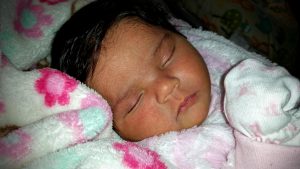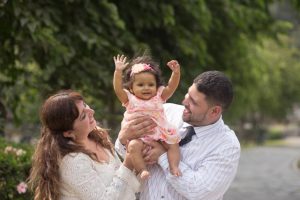
Patricia Alva knew, even before her baby girl was born, that something was wrong. When she was pregnant, doctors detected a cyst on the baby’s stomach during an ultrasound.
“It was heartbreaking,” said Alva.
After she was born, doctors diagnosed baby Olivia with biliary atresia, a rare disease of the liver. It occurs when a baby’s bile ducts do not form normally. It occurs in about 1 in every 15,000 babies.
At only 2 weeks old, Olivia underwent surgery to remove the cyst. Unfortunately, it was only a temporary solution. Doctors knew she’d need a new liver one day.
“It’s a condition we knew would progress,” said Dr. Patrick Healey, division chief of Transplantation at Seattle Children’s. “Biliary atresia is the most common reason for liver transplants in children and accounts for nearly half of the transplants we perform.”
The first year of life for Olivia was hard. She wasn’t gaining weight and her liver was failing slowly.
“I just wanted her to have a normal life,” said Alva. “I didn’t want her to have to wait for a new liver.”
A perfect match

When doctors approached the family about being a living liver donor, Alva didn’t hesitate. The family had two options: they could put Olivia on the wait list and hope an organ would become available before Olivia’s liver failed, or they could get tested to be a living donor.
“I didn’t know it was a possibility, but when we found out about it, I didn’t think twice,” said Alva. “It was my daughter’s life. As a mother, you’d do anything to save your baby’s life.”
Alva was a perfect match for her daughter.
In living-donor liver transplant, surgeons remove only a portion of the donor’s liver and replace the recipient’s diseased liver with the portion of the donor’s healthy liver. As little as 25% of a liver can grow into a whole liver again.
“The liver has a capacity to regrow,” said Healey. “After a liver resection, the liver grows back. It’s regulated like a thermostat; it will continue to grow until it reaches a certain point. For the recipient, the donated portion of the liver will grow with the child as they mature.”

Seattle Children’s is the only pediatric liver transplant program in the Pacific Northwest and has been doing living liver donor transplants since 1999. Seattle Children’s partners with UW Medicine for living-donor liver transplants.
When Alva decided she was going to donate her liver to her daughter, she met with Dr. Martin Montenovo, assistant professor of surgery at the University of Washington, and his transplant team.
“I always tell the donor, you’re becoming a super hero,” said Montenovo. “We want to make sure the process – the surgery, hospital stay and recovery – is as smooth as possible. We coordinate with Seattle Children’s, building a team for both the donor here at UW Medical Center and for the recipient at Seattle Children’s. Living donors are integral in getting more livers to the kids who need them.”
Giving up a piece of herself
On June 28, Alva and Olivia both went into an operating room, one at UW Medical Center (UWMC), the other at Seattle Children’s. Alva had a portion of her liver removed for her daughter. Olivia had her diseased liver removed and it was replaced with a piece of her mother’s. Both surgeries were successful.
“I knew I was giving my baby an opportunity to have a better life,” said Alva. “There was no available liver and hers was so damaged. She needed one, and I didn’t want her to wait.”
According to Healey, one of the biggest advantages of living-liver donation is that the donor and recipient have more control over the transplant process. In deceased donor transplants, organs can become available at any time, and so the recipient has little control over when a transplant will occur. Also, to be eligible for a liver, a patient has to be very sick.
“Many families don’t want their child waiting on a list with no end in sight,” said Healey.
UWMC has the only living-donor program in the Northwest approved by the United Network for Organ Sharing (UNOS), and so it’s not widely available to families at other centers across the country.

“I think it gives our families more hope,” said Healey. “Every transplant option is available to our families because of our expertise here at Seattle Children’s and collaboration with the University of Washington. It gives them a sense of control, and they feel like a part of the team.”
A new lease on life
Today, Olivia is doing incredibly well. She’s gaining weight and has strength to do activities.
“She’s wonderful,” said Alva. “She would never eat before and now she eats everything. The doctors at Seattle Children’s and her whole team, they are amazing. They gave me hope that my baby would have a chance and an opportunity to have a new start. Now, she does.”
Olivia will continue to receive care at Seattle Children’s and will be on medication to suppress her immune system so her body doesn’t reject her liver, but according to Healey she has a bright future.
“My message to other families is to never lose hope,” said Alva. “We never knew this would be an option, but it gave my daughter a chance at life.”

